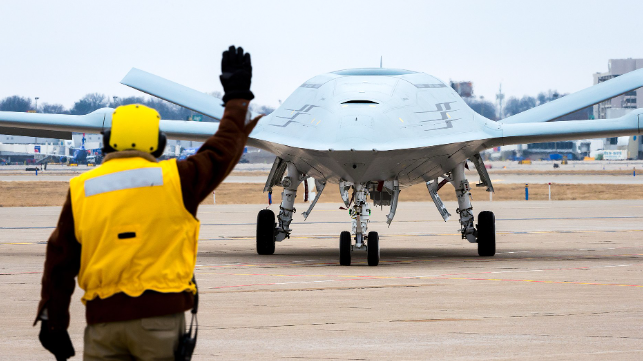U.S. Navy Sets up Separate Manning for Unmanned Aircraft

The U.S. Navy is ramping up manning for its first catapult-launched unmanned aircraft, the MQ-25 Stingray. This stealthy tanker drone will relieve the burden on manned airframes and extend the reach of the Navy's fighters. As in the Air Force, the Navy's drone pilots will be recruited and trained on their own separate track - an arrangement that raises questions about the career path for the Navy's future unmanned ship-drivers.
When it is delivered beginning in 2024, the Stingray will be operated by sailors in a new warrant officer rank, the Aerial Vehicle Operator (AVO). The Navy plans to recruit and train about 450 warrant officers in the unmanned aviation specialty over the span of the next decade, and the career path for AVOs will be distinct from that for manned aviation. They will be able to progress in pay grade up to W-5 (about $100,000 per year), but unlike traditional aviators, they are not expected to advance into command positions outside of their specialty. Their COs and XOs, as well as squadron department heads, will be aviators and flight officers.
"Naval aviators and naval flight officers require assignments that progress in tactical and leadership scope to be competitive for promotion, while warrant officer AVOs will be technical specialists and spend their careers as operators," said Capt. Christopher Wood, the aviation officer community manager at the Bureau of Naval Personnel.
The U.S. Air Force also has a separate training and staffing track for its remotely-operated drone fleets, which are primarily staged overseas and piloted by personnel in the United States. Air Force remotely piloted aircraft (RPA) pilots are recruited from the general population, without any required prior aviation experience, and they are signed to six-year tours. The specialty is new, but USAF staff told the Government Accountability Office that they expect a pilot and copilot attrition rate of 30 percent per year. The high turnover is driven by the Air Force's specific workplace arrangements, but pilots also cited concerns about promotion opportunities for their specialty, which is separate from the rest of the aviation community.
This is not just a question for aviation. As the Navy is increasingly interested in developing unmanned surface vessels, the service will soon have to consider the recruitment track and career path for remote ship-drivers. Will they be technical specialists, set to "captain" remote vessels throughout their time in the service, or will they serve at the helm of manned vessels and at the offices of shoreside commands as well? It is also a question for the commercial maritime industry: Now that the world's first autonomous merchant ship has been delivered, the first unmanned merchant mariners will be seated in a shoreside control station soon.
The opinions expressed herein are the author's and not necessarily those of The Maritime Executive.

